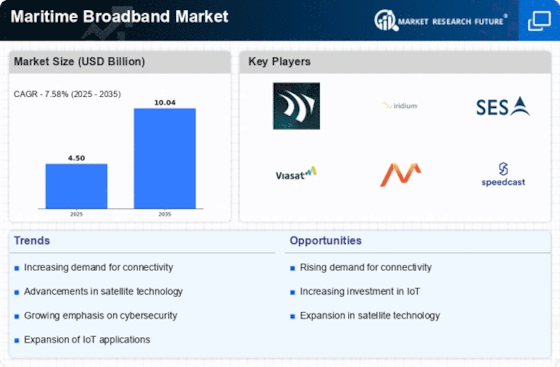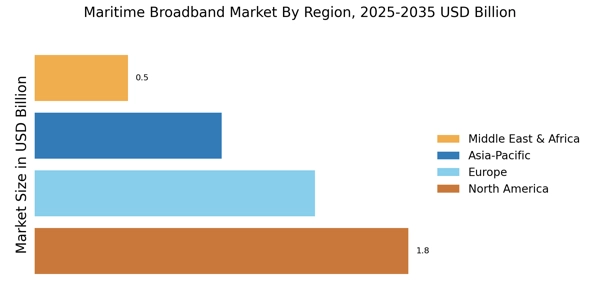Increased Demand for Connectivity
The demand for connectivity within the Maritime Broadband Market is surging, driven by the need for real-time data exchange and communication. As shipping and maritime operations become increasingly digitized, the reliance on robust internet connectivity has intensified. This trend is particularly evident in sectors such as shipping logistics, where companies utilize advanced tracking systems and automated processes that require constant internet access. Furthermore, the rise of remote work and telemedicine on vessels has created a pressing need for reliable broadband services. Market data indicates that the number of connected vessels is expected to reach over 50,000 by 2026, highlighting the growing importance of maritime broadband solutions. This increasing demand is likely to spur investments in infrastructure and service offerings, thereby propelling the overall growth of the Maritime Broadband Market.
Regulatory Support and Frameworks
Regulatory support plays a pivotal role in shaping the Maritime Broadband Market. Governments and international organizations are increasingly recognizing the importance of reliable maritime communication systems for safety and operational efficiency. Initiatives aimed at enhancing maritime connectivity, such as the International Maritime Organization's (IMO) guidelines on communication standards, are fostering a conducive environment for market growth. Additionally, regulatory frameworks that promote competition among service providers are likely to lead to improved service quality and reduced costs for end-users. As regulations evolve to accommodate new technologies and services, the Maritime Broadband Market is expected to benefit from increased investment and innovation. This supportive regulatory landscape may also encourage the adoption of next-generation technologies, further enhancing the capabilities of maritime broadband services.
Expansion of E-commerce and Digital Services
The expansion of e-commerce and digital services is significantly influencing the Maritime Broadband Market. As more businesses adopt digital platforms for operations, the need for reliable internet connectivity on vessels has become paramount. This trend is particularly pronounced in the shipping and logistics sectors, where companies are leveraging digital tools for inventory management, customer engagement, and supply chain optimization. The maritime industry is witnessing a shift towards integrated digital solutions that require constant connectivity, thereby driving demand for advanced broadband services. Market analysts project that the e-commerce sector will continue to grow, with estimates suggesting a potential increase in maritime broadband usage by over 30% in the next few years. This growth trajectory indicates a robust opportunity for service providers to enhance their offerings and cater to the evolving needs of maritime businesses.
Emergence of IoT and Smart Shipping Solutions
The emergence of Internet of Things (IoT) technologies and smart shipping solutions is reshaping the Maritime Broadband Market. IoT devices are increasingly being deployed on vessels to monitor various parameters such as fuel consumption, engine performance, and cargo conditions. These devices require continuous internet connectivity to transmit data to shore-based systems for analysis and decision-making. The integration of smart technologies not only enhances operational efficiency but also contributes to safety and compliance with environmental regulations. Market data suggests that the adoption of IoT in maritime operations could lead to a reduction in operational costs by up to 20%. As the industry moves towards more automated and data-driven operations, the demand for reliable maritime broadband services is expected to rise, presenting significant growth opportunities for service providers in the Maritime Broadband Market.
Technological Advancements in Maritime Broadband
The Maritime Broadband Market is experiencing rapid technological advancements that enhance connectivity at sea. Innovations such as high-throughput satellites (HTS) and 5G networks are revolutionizing maritime communication. These technologies provide higher bandwidth and lower latency, which are crucial for various maritime operations, including navigation, safety, and entertainment. The introduction of software-defined networking (SDN) and network function virtualization (NFV) further optimizes bandwidth usage, allowing vessels to manage their connectivity more efficiently. As a result, the market is projected to grow significantly, with estimates suggesting a compound annual growth rate (CAGR) of over 10% in the coming years. This growth is driven by the increasing need for reliable and high-speed internet access on vessels, which is becoming a standard expectation among crew and passengers alike.


















Leave a Comment